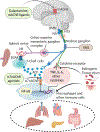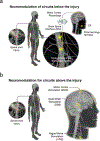Bioelectronic medicine: Preclinical insights and clinical advances
- PMID: 36174571
- PMCID: PMC10155266
- DOI: 10.1016/j.neuron.2022.09.003
Bioelectronic medicine: Preclinical insights and clinical advances
Abstract
The nervous system maintains homeostasis and health. Homeostatic disruptions underlying the pathobiology of many diseases can be controlled by bioelectronic devices targeting CNS and peripheral neural circuits. New insights into the regulatory functions of the nervous system and technological developments in bioelectronics drive progress in the emerging field of bioelectronic medicine. Here, we provide an overview of key aspects of preclinical research, translation, and clinical advances in bioelectronic medicine.
Copyright © 2022 Elsevier Inc. All rights reserved.
Conflict of interest statement
Declaration of interests K.J.T. and V.A.P. have co-authored patents broadly related to the content of this review. They have assigned their rights to the Feinstein Institutes for Medical Research. K.J.T. also declares that he is a consultant to Setpoint Medical.
Figures






Similar articles
-
Bioelectronic Medicine: From Preclinical Studies on the Inflammatory Reflex to New Approaches in Disease Diagnosis and Treatment.Cold Spring Harb Perspect Med. 2020 Mar 2;10(3):a034140. doi: 10.1101/cshperspect.a034140. Cold Spring Harb Perspect Med. 2020. PMID: 31138538 Free PMC article. Review.
-
The Fourth Bioelectronic Medicine Summit "Technology Targeting Molecular Mechanisms": current progress, challenges, and charting the future.Bioelectron Med. 2021 May 24;7(1):7. doi: 10.1186/s42234-021-00068-6. Bioelectron Med. 2021. PMID: 34024277 Free PMC article.
-
Recent Advancements in Bioelectronic Medicine: A Review.Curr Drug Deliv. 2024;21(11):1445-1459. doi: 10.2174/0115672018286832231218112557. Curr Drug Deliv. 2024. PMID: 38173212 Review.
-
Bioelectronic Medicine: a multidisciplinary roadmap from biophysics to precision therapies.Front Integr Neurosci. 2024 Feb 19;18:1321872. doi: 10.3389/fnint.2024.1321872. eCollection 2024. Front Integr Neurosci. 2024. PMID: 38440417 Free PMC article. Review.
-
Closed-loop bioelectronic medicine for diabetes management.Bioelectron Med. 2020 May 15;6:11. doi: 10.1186/s42234-020-00046-4. eCollection 2020. Bioelectron Med. 2020. PMID: 32467827 Free PMC article. Review.
Cited by
-
B cells modulate lung antiviral inflammatory responses via the neurotransmitter acetylcholine.Res Sq [Preprint]. 2024 Jun 25:rs.3.rs-4421566. doi: 10.21203/rs.3.rs-4421566/v1. Res Sq. 2024. Update in: Nat Immunol. 2025 May;26(5):775-789. doi: 10.1038/s41590-025-02124-8. PMID: 38978583 Free PMC article. Updated. Preprint.
-
Is the post-COVID-19 syndrome a severe impairment of acetylcholine-orchestrated neuromodulation that responds to nicotine administration?Bioelectron Med. 2023 Jan 18;9(1):2. doi: 10.1186/s42234-023-00104-7. Bioelectron Med. 2023. PMID: 36650574 Free PMC article.
-
Recent advances in facilitating the translation of bioelectronic medicine therapies.Curr Opin Biomed Eng. 2025 Mar;33:100575. doi: 10.1016/j.cobme.2024.100575. Epub 2024 Dec 20. Curr Opin Biomed Eng. 2025. PMID: 39896232
-
Vagus nerve stimulation and inflammation: expanding the scope beyond cytokines.Bioelectron Med. 2022 Dec 1;8(1):19. doi: 10.1186/s42234-022-00100-3. Bioelectron Med. 2022. PMID: 36457107 Free PMC article.
-
A bibliometric analysis of 100 top-cited journal articles related to acupuncture regulation of the autonomic nervous system.Front Neurosci. 2022 Dec 22;16:1086087. doi: 10.3389/fnins.2022.1086087. eCollection 2022. Front Neurosci. 2022. PMID: 36620457 Free PMC article.
References
-
- AL-ALY Z, XIE Y. & BOWE B. 2021. High-dimensional characterization of post-acute sequelae of COVID-19. Nature, 594, 259–264. - PubMed
Publication types
Grants and funding
LinkOut - more resources
Full Text Sources

